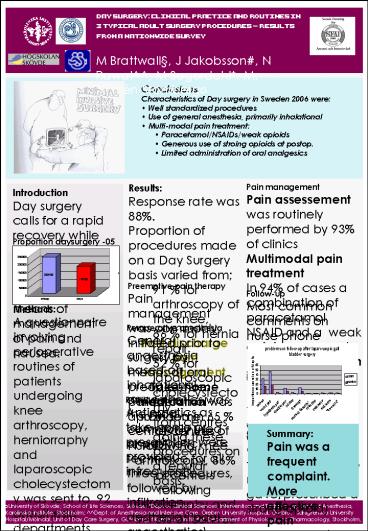Post discharge pain management - PowerPoint PPT Presentation
1 / 1
Title:
Post discharge pain management
Description:
Use of general anesthesia, primarily inhalational. Multi-modal pain treatment: ... followed by infiltration aesthesia (local anaesthetics) and only in few ... – PowerPoint PPT presentation
Number of Views:78
Avg rating:3.0/5.0
Title: Post discharge pain management
1
Day Surgery Clinical practice and routines in 3
typical adult surgery procedures - Results from a
nationwide survey
M Brattwall, J Jakobsson, N Rawal, M
Segerdahl, M. Warrén-Stomberg
- Conclusions
- Characteristics of Day surgery in Sweden 2006
were - Well standardized procedures
- Use of general anesthesia, primarily
inhalational - Multi-modal pain treatment
- Paracetamol/NSAIDs/weak opioids
- Generous use of stroing opioids at postop.
- Limited administration of oral analgesics
Results Response rate was 88. Proportion of
procedures made on a Day Surgery basis varied
from 91 for arthroscopy of the knee, 86 for
hernia repair 52 for laparoscopic
cholecystectomy from centres doing these
procedures on a regular basis.
Pain management Pain assessement was routinely
performed by 93 of clinics Multimodal pain
treatment In 94 of cases a
combination of paracetamol, NSAID and a weak
opioid were used Rescue medication in recovery
phase Primarily ketobemidon IV After discharge
from hospital Oral tramadol/oxycodone (44 never
gave/prescribed a strong opioid)
Introduction Day surgery calls for a rapid
recovery while maintaining safe and adequate
quality care by means of management of pain and
nausea.
Proportion daysurgery -05
Preemptive pain therapy Pain management was
commonly initiated prior to surgery by means of
oral preoperative paracetamol and in some centres
by use of NSAID.
Follow-up Most common comments on nurse phone
follow-up on day 1-2 after surgery were related
to pain and emesis, followed by questions about
wound dressing.
Methods A questionnaire involving
perioperative routines of patients undergoing
knee arthroscopy, herniorraphy and laparoscopic
cholecystectomy was sent to 92 anesthesia
departments nationwide. The focus was on
anaesthetic techniques, postoperative analgesia,
and postoperative follow-up. The 3 presented
typical cases were Patient A A 31-year old
healthy man undergoing knee arthroscopy after a
sports injury. Patient B A 74-year old man who
is admitted for inguinal hernia repair. ASA class
I-II. Patient C A 53-year old woman who is
admitted for laparoscopic cholecystectomy. ASA
class I-II.
Peroperative anesthesia General anaesthesia based
on inhalational anaesthetics was the most
commonly used anaesthetic technique for all three
procedures, followed by infiltration aesthesia
(local anaesthetics) and only in few hospitals by
regional anaesthesia (spinal/epidural).
PONV strategy Antiemetics as take-home or
prescription were provided infrequently.
Summary Pain was a frequent complaint. More
effective pain treatment is needed. Long term
follow up was unusual.
Post discharge pain management Take-home
medication was provided in 65 of centres
following knee arthroscopy, 86 of centers
following herniorraphy and in 73 of centres
after laparoscopic cholecystectomy.
University of Skövde School of Life Sciences,
Skövde Dept of Clinical Sciences, Intervention
and Technology, Dept. of Anesthesia, Karolinska
Institute, Stockholm Dept. of Anesthesia and
Intensive Care, Örebro University Hospital,
Örebro Sahlgrenska University Hospital/Mölndal,
Unit of Day Care Surgery, Göteborg Karolinska
Institutet, Department of Physiology and
Pharmacology, Stockholm, SWEDEN































